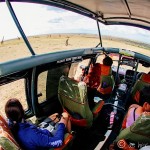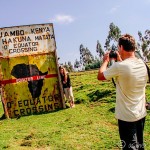While wildlife is probably the main reason tourists come to Masai Mara, another highlight is a village visit.
There are around one million Maasai people living near the Kenya / Tanzania border. They live in semi-nomadic communities and cattle plays a big role in their daily life. (Quick grammar note: both spellings — Masai and Maasai — are acceptable, although the former usually refers to the reserve while the latter refers to the people.)
Maasai groups tend to arrange their huts in a circle, allowing cattle to roam during the daytime but bringing them back to the center of their circle in the evening.
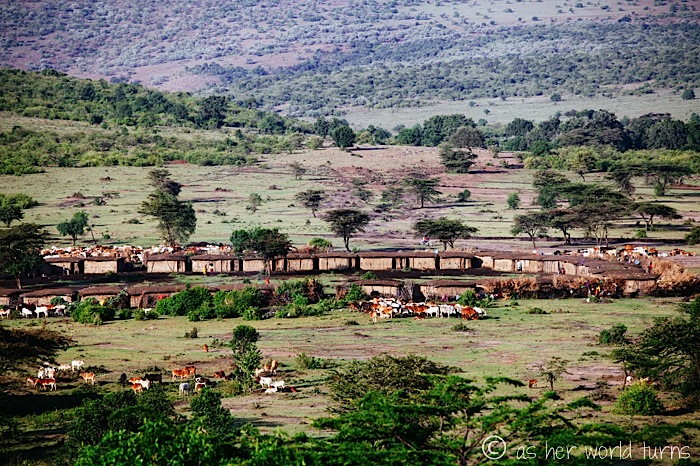
Village visits are a common tourist activity and these locals are happy to show off their way of life for a small fee (around $12). They’ll also perform a few traditional songs with dancing and jumping.

Our tour guide picks this particular Masai tribe because the young tribesman below is very kind and speaks English quite well.

The men of Maasi tribes typically wear bright red or purple patterned blankets, which are sold throughout this part of Africa (my sister picks one up as a souvenir during her visit).

Every 15 years or so, a new group of young men (between the ages of 12-25 who have reached puberty and were not part of the previous age set) are initiated as warriors. This involves a painful circumcision with no anesthetic, performed by the elders with a sharpened knife. The boys must endure the procedure in silence. The healing process takes about four months and the warriors wear black for 4-8 months following the circumcision. During this time they live together, apart from their families. Once the new generation of warriors is initiated, the previous group graduates to become junior elders, who have more of a say in political decisions and interact with the senior elders.
Traditionally, women were also circumcised as part of their coming-of-age ritual and then considered ready for an arranged marriage. Women who refused circumcision were given a lower status, however in recent years a “cutting with words” ceremony featuring singing and dancing has in some cases replaced genital mutilation. It should be noted that female genital cutting is now illegal in both Kenya and Tanzania, however the practice is still deeply ingrained in the Maasi culture.

Warriors show off their headdresses and elaborate beaded necklaces. While the headdresses are for special ceremonies (or tourist visits), most of the Maasai people do indeed wear this traditional dress and beading on a daily basis. We see them throughout this area and in the following weeks in Tanzania, always sporting these bright colors.

My fellow tour mate Kamani shows off a traditional Maasi blanket:


I’m confused by the shells on this headdress because the Masai Mara is nowhere near the ocean.



Young children surround our group as soon as we enter. They’re friendly, inquisitive, and happy to pose for photos (without demanding payment). It’s fun to interact with them.


Our guide shows off his weapons.


And then he shows us how to start a fire using only sticks and friction:



It’s a common practice for Maasi people to knock out a tooth because it’s believed to be the root of illness. This warrior below shows off the gap in his lower set of teeth:

Most of the Maasi men have stretched their ear lobes, long enough to entirely wrap around the top part of the ear… like the Mursi tribes in Ethiopia (although the Maasi people don’t cut their lips).

While the warriors talk about daily life and show off their village, the children following us steal the show.


The most senior member of the village comes over to say hello. Someone tells us he’s 90, another person tells us he’s 100. Who knows, maybe he’s only 70! But he’s deeply respected by the young warriors.



For the record, he’s not wearing anything under that orange blanket. I glimpse him scratching himself down there and moments later he reaches out with the same hand to greet a newly arrived member of our group. I watch this in slow motion, wanting to warn “NOOOO!” but they shake hands… gross.
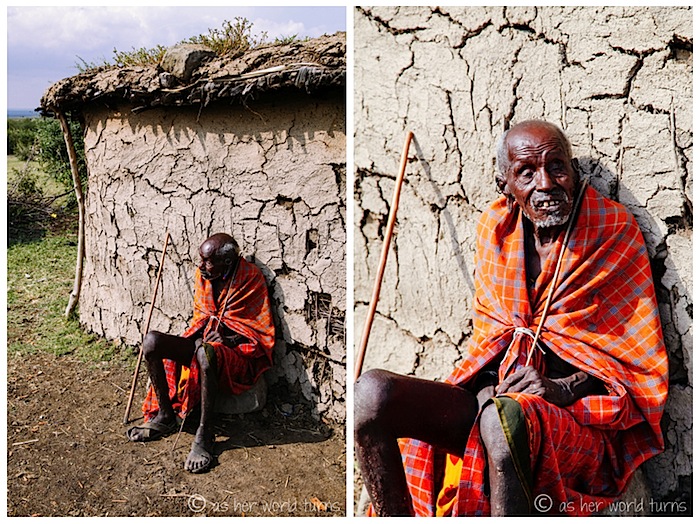
We enter one of the huts. The tight quarters are divided into a kitchen area, sleeping area, and sitting area.




The warriors are known for their high jumps, which they eagerly show off during a traditional dance.


The warriors invite members of our group to join them.




The women perform next. They don’t dance, but they sing a Maasi song.



Here’s some short footage of the group singing and dancing:
We’re encouraged to purchase homemade jewelry and trinkets but the prices are rather exaggerated.



One warrior tries to sell me this lion’s tooth by swearing it will keep mosquitoes away. Nice try!

Our group is quickly lured away by the energetic children who keep demanding our attention, and we are only too happy to give it.



Cheryl has brought bracelets made by a friend’s daughter in Australia; the children eagerly put them on.


Cheryl snaps a photo to send the girl who made the bracelets. They are very well received!
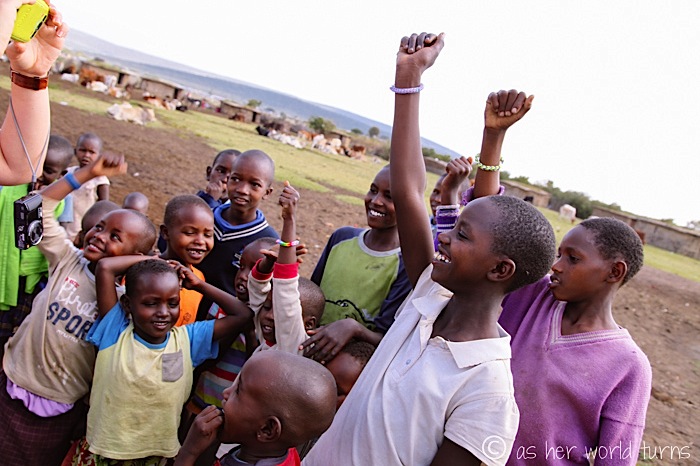
We spend the last 15 minutes of our hour-long visit playing with the children, taking photos as they make funny faces.




Kids LOVE to look at our photos. As soon as we take one, they insist we turn the camera around and show them how it came out. Then they giggle and pose some more. They don’t hesitate to swipe at our iPhone screens to look at our other photos. For a rather indigent community in Africa, they’re not unaware of how cell phone technology works.




The kids are totally endearing and our group can’t get enough.
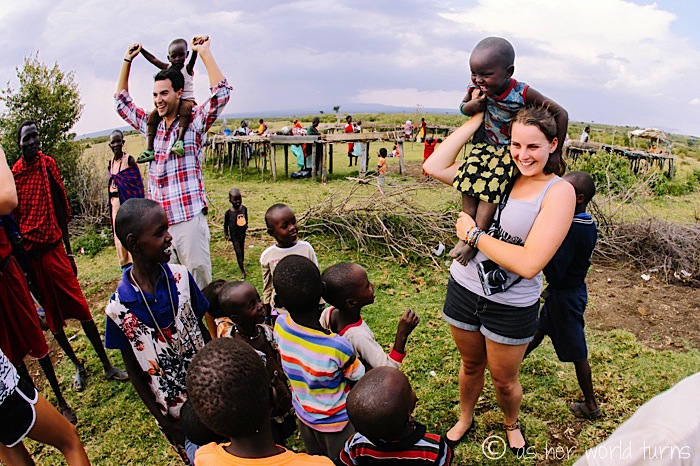
Cattle plays an important role — in many ways, THE most important role — in Maasi culture. A common greeting translates to, “I hope your cattle are well.” They are a symbol of wealth and a source of pride. Cows feature prominently in rituals and customs: exchanged between families during a wedding, as payment for fines, as a gift to establish peace, and as a sacrifice during birth or death ceremonies.
Once a month, blood is drawn from each cow, usually to be mixed with milk for drinking. The warriors us a short blunt arrow fired from close range to pierce the cow’s neck; the blood is caught with a gourd. The wound is not fatal and is stopped afterwards with a wad of mud. Cows are rarely slaughtered (an exception would be during famine).

The elderly tribesmen comes back over as our group prepares to depart. He gestures for a cigarette and Immy (short for Imogen) offers him one. He’s delighted.



We bid adieu to our new Maasi friends. Our primary guide, pictured below, was exceptionally well-versed and soft-spoken.

A few weeks later my tour group will visit another Maasi village in Tanzania, and I’ll elect to stay behind in our vehicle since I’ve already seen the tribe featured in this post. When my tour mates return, they’ll be less enthused about the experience because they were aggressively hounded to purchase items from the community. I’m grateful this visit in the Masai Mara felt more relaxed and authentic without pressure to hand over money.
Thanks to Acacia Africa for discounting the 18-day Mountain Gorillas to the Mara tour in exchange for blogging and photography. Opinions are my own.



